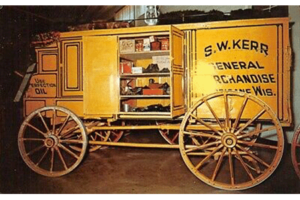Pioneer Village is a museum located in Minden, Nebraska, it was created in hopes to preserve and showcase the evolution of historical artifacts that we still see today. Something they take pride in is their wagons and carts that they showcase throughout their 20 acres of land. Here is a few listed below, along with some fun facts and why they are important enough to be showcased:
- Pioneer Ice Co. Cart
- An Ice wagon/cart was created for domestic and small commercial customers in need of ice in rural areas. Its purpose was exactly what you’re thinking, to transport ice to those that wanted or needed it. Once delivered by a horse, buggy, and your ice delivery man it was kept in what is known as an “ice box”. The term “ice box” is something many of us have heard our parents and grandparents refer to the refrigerator as. There were many companies which provided this service, which is where the “Pioneer” aspect comes from on the cart showcased at Pioneer Village. Now, in most homes now your refrigerator has an ice maker so there is no need for an ice delivery company.

- Milk Wagon, Sanitary Dairy
- A milk wagon is similar to the ice cart; it was created to bring milk to customers. Milk wagons were mainly used for domestic purposes which started in the late 1700’s as most industrialized towns would purchase milk from a local dairy farmer instead of owning and maintaining their very own family cow. When dairy farmers became a “commercial business”, usually the farmers would go door to door selling milk in metal barrels which were carried by their milk wagons. We now rarely see these as most of us buy milk in our local grocery stores, making these wagons a historical artifact.
- A sanitary dairy wagon/cart is very similar to a milk wagon, though it was a more developed version of a milk wagon. A huge difference was the fact that the milk and dairy products that are provided on the sanitary dairy wagon are usually more processed, and there were usually more products to choose from, such as cream and butter.
- U.S. Mail Wagon
- The U.S. Mail Wagon served the same purpose as our mailman’s today, the big difference was that wagon was a horse drawn buggy. U.S. Mail wagons however weren’t created until the late 1870’s, and used to transport mail between train stations, postal offices, and rural areas. They are obviously no longer used, though it is a perfect example of newer generations being able to see how historical ways of living are still concepts we use today.

- S.W. Kerr General Merchandise Wagon
- A general merchandise wagon was also known as a “goods wagon”, it basically carried your everyday goods on one wagon. We see this now in trains freight cars more than anything. Another modern example could be what is known as “piggy-backing” in marketing, better known as land transportation through semis and rail cars. It was a way of getting you everyday goods in rural communities, that you would now go to a big box store to purchase.

- Gillan’s Bread Wagon
- A bread wagon was to transport bread and other baked goods. Gillan’s is a bakery company, well known for baking goods and products today. Though, a bread wagon started from bakers in the communities selling their baked goods, the majority of customers needing freshly baked bread which we would buy from bakeries or grocery stores today.
These are just a few of the small retailer’s carts and wagons showcased in Pioneer Village’s collection. The goal of this collection is to show each artifact and the development in a chronological timeline in hopes to show how far we have come in evolving these inventions. Hopefully these few carts/wagons have sparked your interest, and maybe you’ll just have to come take a look yourself!


Recent Comments